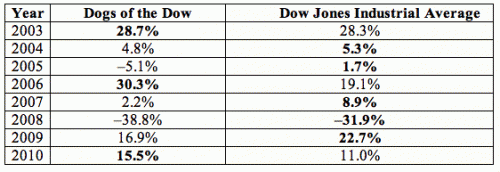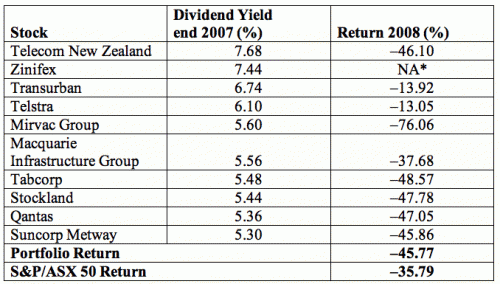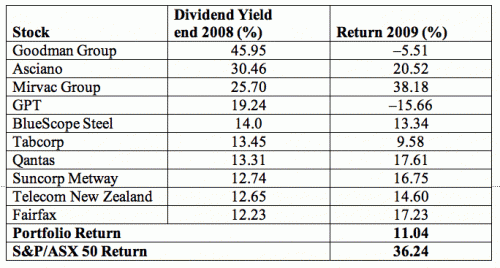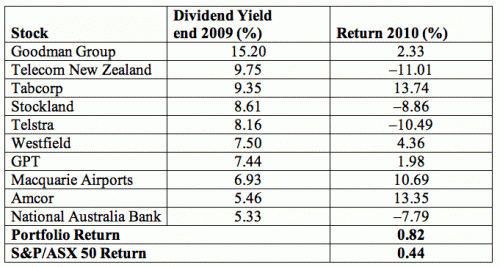Stockmarket investors who don’t want to go to the trouble of sifting through stock tips or poring over charts for under-valued trading opportunities can always fall back on a ‘mechanical’ strategy, where the investor simply buys stocks that fit a selection criterion, or set of criteria.
It could be the stocks with the lowest price/earnings (P/E) ratios, the highest dividend yields or the lowest price-to-NTA (net tangible assets) ratios.
One of the most famous mechanical strategies – if not the most famous – is the Dow Dividend, or “Dogs of the Dow.” The idea of the Dogs of the Dow is to buy blue-chip stocks after they have been beaten down in price. How you tell this is to look at the dividend yields – a high yield means that the price of the shares has fallen.
With this value-oriented strategy, you take a sample of the 30 stocks in the Dow Jones Industrial Average (DJIA), and buy equal amounts of the ten stocks that show the highest dividend yield (using the most recent dividend). After a year, when the top-yielding list is updated, you keep the ones that are still on the list and sell those that have fallen off.
A variant of the strategy is the “Pigs of the Dow”, in which at the end of the year, the investor buys the five worst-performed Dow stocks in terms of price decline that year. At the end of the following year, the Pigs are sold and that year’s five biggest losers are bought.
But it’s the Dogs approach that is most popular, and for good reason: it has usually done very well for its followers. From 1929 to 2003, the Dogs of the Dow strategy outperformed the stockmarket (the S&P 500 index) handily, returning about 14 per cent a year compared to the market return of 11.7 per cent a year during that time.
However, the Dogs strategy has generated mixed results recently, being battered by a low weighting to technology in 1999-2000 and hurt in 2007-08 by financial and consumer-related stocks. Between 1995 and 2009, the Dogs have shown a compound annual return of 7.6 per cent, versus 8 per cent for the S&P 500 and 9.2 per cent for the DJIA.
The idea is that the ten names will continue to throw off solid dividends and possibly even raise their yields in the coming year. Of course, the strategy also assumes that investors will see solid price appreciation in the future. Critics say the Dogs strategy doesn’t incorporate any financial analysis and thus can’t predict the sustainability of the dividends.
Below are the results for the Dogs and the Dow for the last eight years.

With the help of Morningstar Research, let’s have a look at how the strategy has worked in Australia, using the stocks of the S&P/ASX 50. Let’s call them – and this is not original – the “Dingoes of the ASX 50”.

The situation in the kennel does not look good. The market has beaten the Dingoes of the ASX 50 for the last six years.
Let’s look at the strategy in detail in the last three years.
2008 Dogs

* Zinifex delisted 2 July 2008
2009 Dogs

2010 Dogs

The strategy did Ok in 2010 – but it is definitely not shooting the lights out.
The major problem is the fact that the Dogs/Dingoes strategy is based on dividend yields: this means that it is biased against resources companies, which are usually not big dividend payers, preferring to reinvest profits in ongoing exploration or mine/oilfield development activities.
In contrast, when applied to the Australian context it ends up being overly biased to REITs (real estate investment trusts) and infrastructure stocks, which pay large distributions (there are none of these in the Dogs of the Dow.)
The last three years on the Australian market have seen over-geared REITs and infrastructure companies fall into diabolical trouble: these would have shown up in the Dingoes of the ASX 50, but the high yields that caused them to show up were the classic high yields that were too good to be true. There was no way, in the changed circumstances after the GFC hit, that their historic dividends/distributions – on which the high yields were based – were maintainable. You only have to look at the performance of the 2008 dogs to see that.
The problem is that the Dogs of the Dow is difficult to apply in Australia, where just seven stocks – the four big banks, BHP, Rio Tinto and Wesfarmers – account for the vast bulk of the movement of the market indices: the S&P/ASX 200, and certainly the S&P/ASX 50. But with dividend yields of less than 2 per cent, BHP and Rio are never going to make it into the Dingoes list. And the A-REITs and infrastructure stocks – which make large distributions and do qualify for the Dingoes of the ASX 50 – have had a diabolical time on the market, a massive shake-out of debt, which has slashed the value of the stocks. So the Dingoes strategy by design has excluded the stocks doing the best on the market, and included those doing worst. That’s not a great look for a mechanical strategy that is supposed to beat the market.
If you want an easy-to-follow, low-maintenance, low-transaction-costs strategy that only takes a few minutes to change, once a year – and which will turn out to be pretty tax-effective – you could try the Dingoes of the S&P/ASX 50, and hope that over the longer-term, it will have similar success to the Dogs of the Dow.
The Dingoes of the S&P/ASX 50 has been unfairly pummeled in recent years as its central premise has caused it to buy some of the market’s worst situations (remember, a high yield can indicate trouble; and it did in the GFC.) You do have to recognise the strategy’s in-built failings in the Australian market. It is difficult for the Dingoes strategy to do well when it does not pick up the central theme that is powering the Australian stockmarket at present.